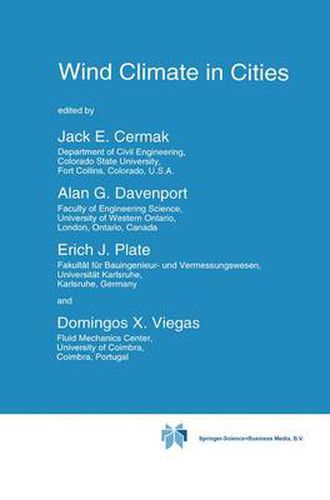Readings Newsletter
Become a Readings Member to make your shopping experience even easier.
Sign in or sign up for free!
You’re not far away from qualifying for FREE standard shipping within Australia
You’ve qualified for FREE standard shipping within Australia
The cart is loading…






This title is printed to order. This book may have been self-published. If so, we cannot guarantee the quality of the content. In the main most books will have gone through the editing process however some may not. We therefore suggest that you be aware of this before ordering this book. If in doubt check either the author or publisher’s details as we are unable to accept any returns unless they are faulty. Please contact us if you have any questions.
If one surveys the development of wind engineering, one comes to the conclusion that the challenge of urban climatology is one of the most important remaining tasks for the wind engineers. But what distinguishes wind engineering in urban areas from conventional wind engineering? Principally, the fact that the effects studied are usually unique to a particular situation, requiring consideration of the surroundings of the buildings. In the past, modelling criteria have been developed that make it possible to solve environmental problems with great confidence, and studies validated the models: at least in a neutrally stratified atmosphere.
The approach adopted in the book is that of applied fluid mechanics, since this forms the basis for the evaluation of the urban wind field. Variables for air quality or loads are problem specific, or even random, and methods for studying them are based on risk analysis, which is also presented. Criteria are developed for a systematic approach to urban wind engineering problems, including parameter studies.
The five sections of the book are: Fundamentals of urban boundary layer and dispersion; Forces on complex structures in built-up areas; Air pollution in cities; Numerical solution techniques; and Posters. A subject index is included.
$9.00 standard shipping within Australia
FREE standard shipping within Australia for orders over $100.00
Express & International shipping calculated at checkout
This title is printed to order. This book may have been self-published. If so, we cannot guarantee the quality of the content. In the main most books will have gone through the editing process however some may not. We therefore suggest that you be aware of this before ordering this book. If in doubt check either the author or publisher’s details as we are unable to accept any returns unless they are faulty. Please contact us if you have any questions.
If one surveys the development of wind engineering, one comes to the conclusion that the challenge of urban climatology is one of the most important remaining tasks for the wind engineers. But what distinguishes wind engineering in urban areas from conventional wind engineering? Principally, the fact that the effects studied are usually unique to a particular situation, requiring consideration of the surroundings of the buildings. In the past, modelling criteria have been developed that make it possible to solve environmental problems with great confidence, and studies validated the models: at least in a neutrally stratified atmosphere.
The approach adopted in the book is that of applied fluid mechanics, since this forms the basis for the evaluation of the urban wind field. Variables for air quality or loads are problem specific, or even random, and methods for studying them are based on risk analysis, which is also presented. Criteria are developed for a systematic approach to urban wind engineering problems, including parameter studies.
The five sections of the book are: Fundamentals of urban boundary layer and dispersion; Forces on complex structures in built-up areas; Air pollution in cities; Numerical solution techniques; and Posters. A subject index is included.